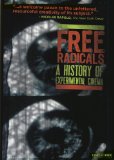| Reviews & Columns |
|
Reviews DVD TV on DVD Blu-ray 4K UHD International DVDs In Theaters Reviews by Studio Video Games Features Collector Series DVDs Easter Egg Database Interviews DVD Talk Radio Feature Articles Columns Anime Talk DVD Savant Horror DVDs The M.O.D. Squad Art House HD Talk Silent DVD
|
DVD Talk Forum |
|
|
| Resources |
|
DVD Price Search Customer Service #'s RCE Info Links |
|
Columns
|
|
|
Free Radicals: A History of Experimental Cinema
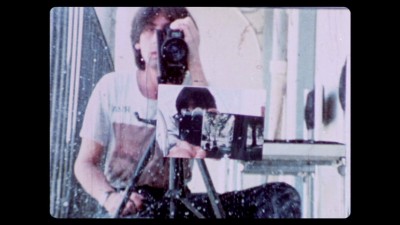
Both the pitfalls and the achievement of the film are already hinted at in the title of Pip Chodorov's documentary Free Radicals: A History of Experimental Film. It avoids making any false promises by wisely referring to itself as "a" history, not "the" history, of the diverse kinds of short, small-scale, non-narrative movies that can be described as experimental (any comprehensiveness clearly being impossible at its compact running time of 82 minutes), and its somewhat lopsided focus -- on the direct predecessors of Chodorov (himself an experimental filmmaker from NYC) from the '60s-era Greenwich Village boom in experimental cinema, a critical mass reached in the messy but intent and fruitful venturing outside of commercial/storytelling film -- is sufficiently acknowledged, and pursued to an interesting enough result, to easily forgive it. But the simultaneously portentous and simplistic "free radicals" part (despite its being taken from the title of a 1958 experimental short by Len Lye, Chodorov isn't afraid to overemphasize his reading-into of those words) gives us a preview of the tone that Chodorov, having cast himself in the role of our affable guide, brings to the proceedings, which is irksomely bland and soft-selling, at times coming close to undermining the film's intention of rousing our interest in something more provocative, challenging, and often extremely specific than any chipper bromides could do justice to.
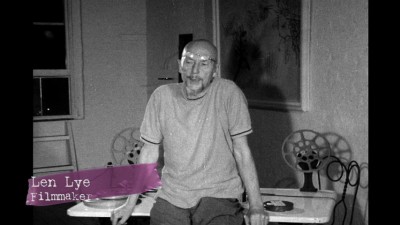
Chodorov's decidedly too-heavy presence is at least partly necessitated as both the framing device and the explanation for his choice of subject and method of exploring it. Chodorov's father (a prominent interviewee in the film) was a TV producer in New York in the '60s and managed to sneak through documentaries on the then newly fecund field of experimental films and their makers, a good number of whom seem to also have been acquaintances or friends, so the younger Chodorov thereby gained a uniquely direct exposure to experimental film, which he fell in love with at a young age (some, but not too many, of his own efforts are present), as well as a personal history with and access to a group of some of the movement's most prominent American directors. He thus starts with his own story vis-à-vis experimental film, gradually connecting his fellow filmmaking friends until Free Radicals becomes strategically and usefully centered Jonas Mekas -- Film-Maker's Cooperative/Anthology Film Archive founder and experimental filmmaker/critic/movement ringleader extraordinaire -- along with several of the expats and bohos whose work Mekas curated, supported, and/or introduced from his Village Voice bully pulpit and open-screen filmmakers' nights: Ken Jacobs (Star Spangled to Death), Robert Breer, and Peter Kubelka, all of whose work Chodorov gives us generous slices of (in addition to glimpses of the films and thoughts of other, more geographically remote but equally acclaimed satellites/personal acquaintances of Chodorov and/or his family, like Stan Brakhage and Stan Vanderbeek), and with whom Chodorov also hangs out as a friend/fellow filmmaker, gleaning on our behalf their recollections and acquired wisdom from decades of experimental filmmaking.
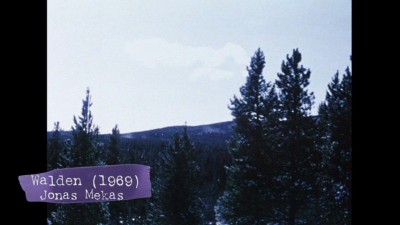
But what helps tie it all together -- the unavoidable presence in the film of Chodorov himself due to his deeply immersed history with and close ties to the source -- also manifests too often as the director's chipper but empty voice-over during the clips, as well as his not exactly self-effacing on-camera presence during the interviews; let's just say that his alternately hyperbolic and high-school-diary-naïve ruminations make it clear why Chodorov is a filmmaker, not a writer. Whatever he pipes in with often has a presumably unintentional but nonetheless glaring air of in-the-know insider's self-regard, despite not having very much of any incisiveness to offer (the gist of most of it is that experimental filmmaking is neat-o, kinda quirky and utopian); his descriptive/interpretive chatter is purposely simplistic and generalizing enough that, when you consider Chodorov's long-term immersion in the scene and the extent to which he must have considered all of the very particular ins and outs of different kinds of experimental filmmaking, it comes off as more than a little bit disingenuous, a put-on naivete that thinks baby-talking to us counts as pure-innocent open-mindedness and a return to the radical/hippie-era roots of experimental film's most shining moment, when in fact it flirts with (but never, thankfully, succumbs to) trivializing the sometimes great work he's trying to introduce us to as the kind of bad, "free-spirited" poetry his more faltering flights of wordplay make him seem fully capable of coming up with.
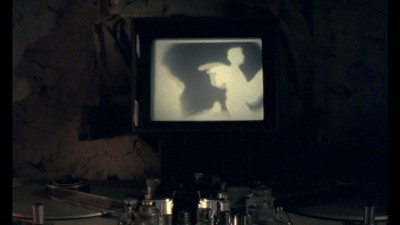
Fortunately, the films and the filmmakers are frequently enough allowed to speak for themselves, without Chodorov's evasive, quasi-harmless commentary. Amid extensive, patient, revealing interviews, contemporary and archival, with Mekas, Breer, Brakhage, Kubelka, Jacobs, Vanderbeek, and Hans Richter, there are plentiful clips encompassing a fairly representative sample of the form: Hans Richter's early work; Maya Deren's 1943 experimental breakthrough (in terms of how well-known it became, at any rate) Meshes of the Afternoon; Rainbow Dance, a gorgeous, unbelievably forward-looking 1935 film by Len Lye (made under the auspices of the British Post Office Bank, for which it serves a double purpose as an advertisement) using a stunningly creative and innovative color process, shown in its entirety here; exemplary snippets from Mekas and Brakhage, forays over to France to look at work and get comments from the Lettrist movement's filmmaking ambassador, Maurice Lemaître, etc. And when he sticks to the more grounded facts, Chodorov actually does become informative and serious; he's not great at explaining the aesthetics or intentions of any of the films he's covering, but he does do an excellent job of rounding out the deep but narrowly-focused footage he has of his select group of filmmakers with, for example, a section in which he covers the sticky issue of how one makes a living as an experimental filmmaker (who occupies, at least in the case of the artists under discussion here, an especially un-lucrative no-man's-land between the uptown art world and the narrative commercial/art cinema). He also does surprisingly well by the history of avant-garde/non-narrative cinema, succinctly but accurately relating the story of the influx of artists-on-film from Europe (who, like Richter, both migrated and made their work in reaction to World War I for a first wave, then, like Mekas, fled the rise of fascism and Nazism in a second) -- a story which flows aptly into his primary focus on the Greenwich Village scene while also allowing him to encompass non-NYC/pre-'60s filmmakers like Richter and Deren.
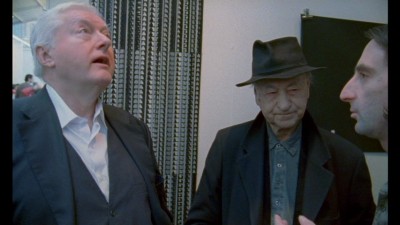
It ultimately doesn't matter so much, then, that Chodorov's presentation of the films is a bit cloying, evasive, and reductive. Where it counts, where he's offering us something about the works that they can't say for themselves -- the stories around and behind the films and their makers, the history, the context -- he comes through for us. And, in the end, despite the odd filter constituted by its director's imposition of his own presence and personality, he does justice to the films, too, just by exposing us to them. Free Radicals: A History of Experimental Film is thus saved from its own potential for oversimplification; scads of visible evidence let us know that there's far more to them than Chodorov's meager characterizations would imply, and their plentiful presence lets us easily look past what we're being told about these fascinating experimental films to the works themselves, rousing our curiosity, making us want more, and rendering Chodorov's film, almost in spite of itself, a successful introduction and invitation to the experimental work for which it's crusading.
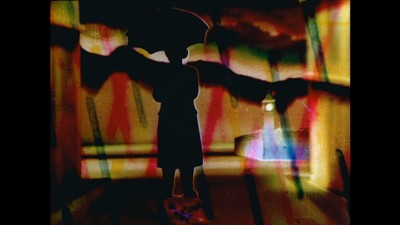
THE DVD:
The transfer of the film presented here, preserving its original 1.66:1 aspect ratio, is quite decent: The different color and textural properties of the various formats used (8, 16, and Super-16) are fairly well-preserved throughout, and the most important parts -- the clips of the older experimental films -- look more or less as they should. There is some aliasing here and there and some slight edge enhancement/haloing noticeable in spots, however, and some sections, particularly the more recently shot footage, looks to have had some of its film texture overly smoothed over via digital noise reduction (DNR).
Sound:The Dolby Digital 2.0 stereo soundtrack gives us the film's sound clear and crisp, so that both the more current sounds (the music chosen by Chodorov, the later interviews) made with the cleaner audio technology of today and the obviously grittier archival stuff are as immediately present, clean, and fully audible as possible, with no undue distortion or imbalance at any point.
Extras:None.
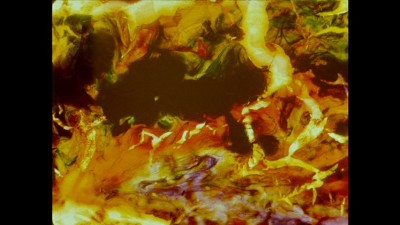
FINAL THOUGHTS:
Free Radicals is billed as a history of experimental cinema, not the history, and director Pip Chodorov goes out of his way, in this documentary about his own medium, to point out how it only scratches the surface; it is by necessity focused on a group of New York filmmakers who came to prominence in the '60s, some of whom formed part of the social circle of Chodorov's family, and a few of whom Chodorov knows today, so ease of access has made them central to his work here. He does reach far and wide enough, however, that the film works well as a pocket history of "personal" or "underground" or "avant-garde" or "experimental" cinema (it's been called so many things), and if his persistent presence as our guide tends to come off a bit wide-eyed and anodyne, his inclusion of bountiful evidence of what he's talking about (sometimes including several-minute experimental works in their entirety) and the in-depth conversations with multiple personages from that generation of filmmakers give us something substantial to hang our hats on. Free Radicals: A History of Experimental Film may lack the depth, bite, or creativity of many of the brave/crazy works it documents, but as a self-confessed broad, general survey brought to us by an enthusiastic practitioner, it's most welcome and useful -- a fine introduction if you're not yet familiar with the '60s-breakthrough Warhol/Brakhage/Mekas school of non-narrative filmmaking and where it came from, and a somewhat slight but still gratifying memento for the initiated. Recommended.
|
| Popular Reviews |
| Sponsored Links |
|
|
| Sponsored Links |
|
|
| Release List | Reviews | Shop | Newsletter | Forum | DVD Giveaways | Blu-Ray | Advertise |
|
Copyright 2024 DVDTalk.com All Rights Reserved. Legal Info, Privacy Policy, Terms of Use,
Manage Preferences,
Your Privacy Choices | |||||||









